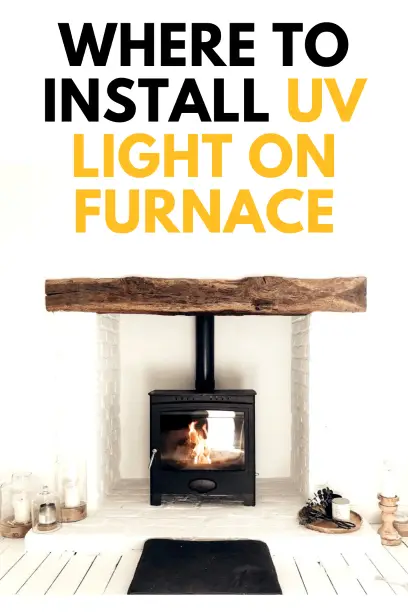
Are you planning to install a UV light on the furnace of your home or office? The first step while beginning to install a UV light in your HVAC systems is to find the right place. Let’s understand the role of the UV lights and where to install them in HVAC systems. In this article, we will also look at some options of UV lights for HVAC systems.
Table of Contents
Where to Install UV Light on Furnace?
An ideal place for installing UV light on a furnace is an area that allows reflections. While looking for a place to install UV lights, you can put them in designated parts of the ductwork of the HVAC systems. It depends upon the requirements and HVAC system that you choose. You may put the UV lights in the air handler or air return system. You can get the maximum benefit from the UV lights when they are installed in reflecting surfaces in combination with high-efficiency filters.
The place where you install the UV light greatly determines its effectiveness in providing the desired outcomes. For example, if a germicidal UV light is installed in an inappropriate place, it will not help prevent the growth of germs and molds.
How to Install UV Light on HVAC Systems?
After choosing the right place to place the UV light, installation of UV lights in your HVAC systems is a simple four-step process. Here’s how you can install UV lights in your HVAC systems.
1. Drill the holes of the right sizes
In order to let the UV light penetrate inside the HVAC unit, you will need to drill some holes. Before getting to drill the holes, make sure to take some measurements from the furnace. Holes of sizes 1.5” to 3” are generally right for installing most of the UV lights available in the market.
It is advisable to cut the power to the furnace before installing the UV lights as not doing so can result in shocks. You may use the paper templates to get some help in installing the UV light.
To drill the holes, slowly push the hole saw at the hole locations and gently allow the saw to work its way into the sheet metal.
2. Screw the UV light to the furnace
To mount the UV light to the air handler, tighten the screws of the UV lights using a cordless drill or a simple screwdriver. It is important to not tighten the screws too much as it may break the plastic around the UV light.
3. Power the UV light
When the UV light system is fully mounted to the HVAC system, power the lights by connecting the extension cords to an existing outlet.
You can power the UV light in such a way that it works only when the HVAC system is ON. This will help you to save energy and increase the life of the UV light. When the light is fully plugged, turn it ON to check if it works or not. You will see a bluish-colored glow in the glass.
4. Clean the bulb and replace it when needed
It is important to clean the UV light bulbs in a few months to remove any dust and debris that may halt the working of the bulb. While most UV light bulbs will last up to a year, you will need to replace the bulb when the bluish glow of the UV light bulb fades away.
Role of UV Lights in HVAC System
There are numerous benefits of UV lights when mounted in HVAC systems. Some of these benefits are listed below.

- In air conditioning systems, the accumulation of debris and dust can result in the decreased airflow. Using UV light in addition to the air filter can boost the airflow of your air conditioning system.
- Airflow of the air conditioning units is also affected by the microbes that accumulated on the HVAC coil. This results in more running time of the air conditioning unit to provide the desired result. UV lights are extremely useful in killing these microorganisms and hence optimize the airflow in the HVAC units. This also improves the efficiency of the systems.
- By improving the airflow and efficiency of your HVAC units, UV lights decrease the energy requirements of the systems.
- UV lights are a great way to inhibit the growth of molds and bacteria which is otherwise impossible in the case of air conditioning units.
- UV lights improve the indoor air quality and help to keep the people inside the room away from allergens.
- Volatile organic compounds occur naturally as well as by man-made processes. These have a significant impact on your health. UV lights help to reduce the amount of volatile organic compounds in your surroundings.
- Over a course of time, moisture inside the air conditioning unit can clog the drain line which can further cause a lot of problems. UV lights reduce the moisture content inside the drain pipes.
UV Light Options for HVAC Systems
There are two types of UV lights used inside HVAC systems namely, coil-sanitizing lights and air-sanitizing lights.
1. Coil-sanitizing Lights
Indoor coils are the hotspot for the growth of molds and bacteria in the case of central air-conditioning systems. The coil condenses the moisture from the air. So when the air passes upon the coil, the dirt and dust particles get stuck to the coil. The coil which is already wet from moisture becomes the breeding ground for bacteria and molds. Single lamp and dual-lamp variants of coil-sterilizing lights are used in such kinds of air-conditioning systems. These UV lights are mounted in such a way that they shine upon the coil directly.
2. Air-sanitizing Lights
This type of UV light is used for disinfecting the air and killing airborne microbes and molds. These are commonly known as germicidal UV lights and put inside the ducts that bring return air to the system. The installation costs for these UV lights are generally high because they need to be hardwired to the HVAC systems.
Conclusion
Installing UV lights in a furnace is easier than it sounds. Make sure to find a good place with lots of reflections. Depending on your HVAC system, you should be able to mount the lights somewhere inside the ductwork. A couple of great spots to put UV lights are the air handler or air return system.

